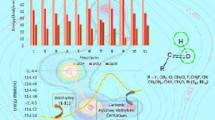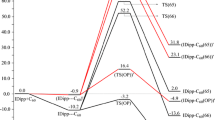Abstract
Carbon-carbon bond deformation curves for fluorinated ethylene molecules and the corresponding carbocations were calculated by the ab initio self-consistent field method in the 5-31G basis set. The maximum force required for bond cleavage was taken as a criterion for bond strength. It has been found that for ethylene, replacement of hydrogen by fluorine insignificantly strengthens the C=C bonds in symmetric molecules. However, in molecules with an asymmetric arrangement of fluorine atoms, the bond is slightly weakened due to different charges on the carbon atoms. The configuration of the corresponding carbocations also depends on the bond polarity: an assymmetric distribution of electron density in the C=C bond region leads to the formation of σ-complexes, while a symmetric distribution of electron density (pure covalent bonding) gives π-complexes. Since the carbon-carbon bond in the σ-complexes is essentially weaker, one should expect significant weakening of the bond in high-acidity media if the bond exhibits any kind of asymmetry (chain branching, defects, etc.). For the considered molecules, an antibatic correlation has been established between the strength criterion Fmax (unlike the dissociation energy) and the bond length.
Similar content being viewed by others
References
Yu. Ya. Kharitonov and G. V. Kravtsova,Koordinats. Khim.,8, No. 9, 1315–1365 (1980).
P. Pulay, inThe Force Concept in Chemistry, B. M. Deb (ed.), Van Nostrand Reinhold, New York (1981), pp. 449–498.
F. W. Averill and G. S. Painter,Phys. Rev. B,34, No. 4, 2088–2096 (1986).
N. D. Chuvylkin, G. M. Zhidomirov, and V. B. Kazanskii,J. Catal.,38, 214–217 (1975).
E. D. Shchukin, V. S. Yushchenko, and T. P. Ponomareva,Kolloid. Zh.,53, No. 2, 319–325 (1991); V. S. Yushchenko, T. P. Ponomareva, and E. D. Shchukin,J. Mat. Sci.,27, 1659–1662 (1992).
G. A. Olaf,J. Am. Chem. Soc.,91, 5801–5809 (1969).
S. Marriott and R. D. Tomson,J. Mol. Struct.,109, 305–310 (1984).
R. F. W. Bader, inThe Force Concept in Chemistry, B. M. Deb (ed.), Van Nostrand Reinhold, New York (1981), pp. 33–197.
J. M. Martell and R. J. Boyd,J. Phys. Chem.,96, 6287–6290 (1992).
N. D. Epiotis,J. Mol. Struct.,168, 15–76 (1988).
T. Berlin,J. Chem. Phys.,19, 208 (1951).
Additional information
Institute of Physical Chemistry, Russian Academy of Sciences, Moscow. Translated fromZhurnal Strukturnoi Khimii, Vol. 36, No. 1, pp. 34–41, January–February, 1995.
Translated by I. Izvekova
Rights and permissions
About this article
Cite this article
Ponomareva, T.P., Yushchenko, V.S. & Shchukin, E.D. Calculation of carbon-carbon bond deformation curves for fluorinated ethylenes and the corresponding carbocations. J Struct Chem 36, 29–35 (1995). https://doi.org/10.1007/BF02577746
Received:
Issue Date:
DOI: https://doi.org/10.1007/BF02577746




